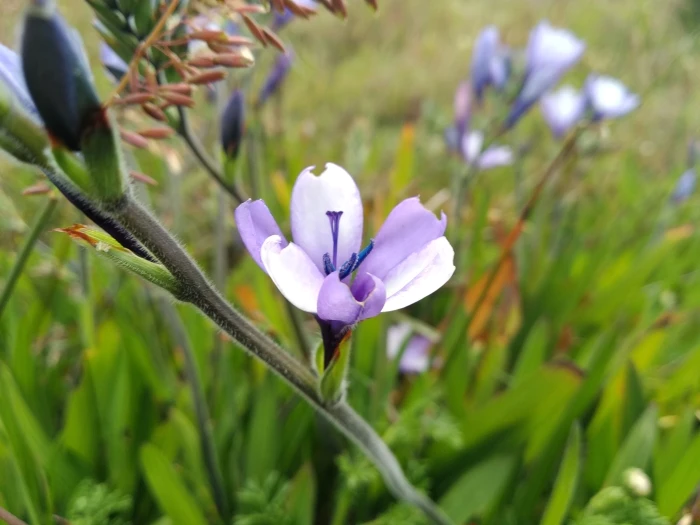Baboon Flower
(Babiana nervosa)
Baboon Flower (Babiana nervosa)
/
/

De Waal Hugo
CC BY 4.0
Image By:
De Waal Hugo
Recorded By:
Copyright:
CC BY 4.0
Copyright Notice:
Photo by: De Waal Hugo | License Type: CC BY 4.0 | License URL: http://creativecommons.org/licenses/by/4.0/ | Rights Holder: De Waal Hugo | Publisher: iNaturalist | Date Created: 2022-09-11T13:22:34-07:00 |

























Estimated Native Range
Climate Requirements for Saint Petersburg, Russian Federation
| This Plant | Your Site | Plant Suitability for Your Location | ||
|---|---|---|---|---|
| • Precipitation | 13" - 108" | 26" | You should be able to grow this plant with no additional irrigation. | Excellent |
| • High Temp. | 72°F - 92°F | 72°F | OK, but your summers are milder than normal for this plant | OK |
| • Low Temp. | 28°F - 54°F | 16°F | Your winter temperatures may be too cold for this plant | Too cold |
This plant may not grow well at your location - your winters are too cold.
Summary
Babiana nervosa, commonly known as Baboon Flower or Babiana, is a deciduous or semi-deciduous perennial bulb. It is native to the fynbos and renosterveld habitats of South Africa, particularly in the Western Cape, where it thrives in well-drained sandy soils on open grasslands, rocky slopes, and sometimes in the shelter of scrub vegetation. Babiana nervosa typically grows to a height of 0.5-1.5 feet (0.15-0.5 meters) and a width of 0.25-0.5 feet (0.1-0.2 meters). The plant features sword-shaped leaves and produces spikes of blue or purple flowers that are quite showy and bloom in the spring. The flowers are fragrant and attract pollinators such as bees.
The Baboon Flower is valued for its striking, vibrant flowers and ease of maintenance. It is often used in rock gardens, borders, and as container plants. Babiana nervosa is drought-tolerant once established, making it suitable for xeriscaping. It requires well-drained soils, preferably sandy or loamy, and can tolerate both full sun and part shade. While it can survive with low water once established, moderate watering during the growing season will promote better blooms. After flowering, the foliage dies back, and the bulbs can rest until the next growing season. It is important to protect the bulbs from excessive moisture during their dormant period to prevent rot.CC BY-SA 4.0
The Baboon Flower is valued for its striking, vibrant flowers and ease of maintenance. It is often used in rock gardens, borders, and as container plants. Babiana nervosa is drought-tolerant once established, making it suitable for xeriscaping. It requires well-drained soils, preferably sandy or loamy, and can tolerate both full sun and part shade. While it can survive with low water once established, moderate watering during the growing season will promote better blooms. After flowering, the foliage dies back, and the bulbs can rest until the next growing season. It is important to protect the bulbs from excessive moisture during their dormant period to prevent rot.CC BY-SA 4.0
Plant Description
- Plant Type: Bulb
- Height: 0.5-1.5 feet
- Width: 0.25-0.5 feet
- Growth Rate: Slow, Moderate
- Flower Color: Blue, Purple
- Flowering Season: Spring, Summer, Fall
- Leaf Retention: Deciduous
Growth Requirements
- Sun: Full Sun, Part Shade
- Water: Low, Medium
- Drainage: Fast, Medium
Common Uses
Border Plant, Low Maintenance, Potted Plant, Rock Garden
Natural Habitat
Fynbos and renosterveld habitats of South Africa, particularly in the Western Cape
Other Names
Common Names: Babiana
Scientific Names: Babiana nervosa, Babiana caesia, Babiana erectifolia, Babiana flavocaesia, Babiana stricta, Babiana stricta, Babiana stricta var. erectifolia, Babiana stricta var. stricta, Gladiolus nervosus
GBIF Accepted Name: Babiana nervosa